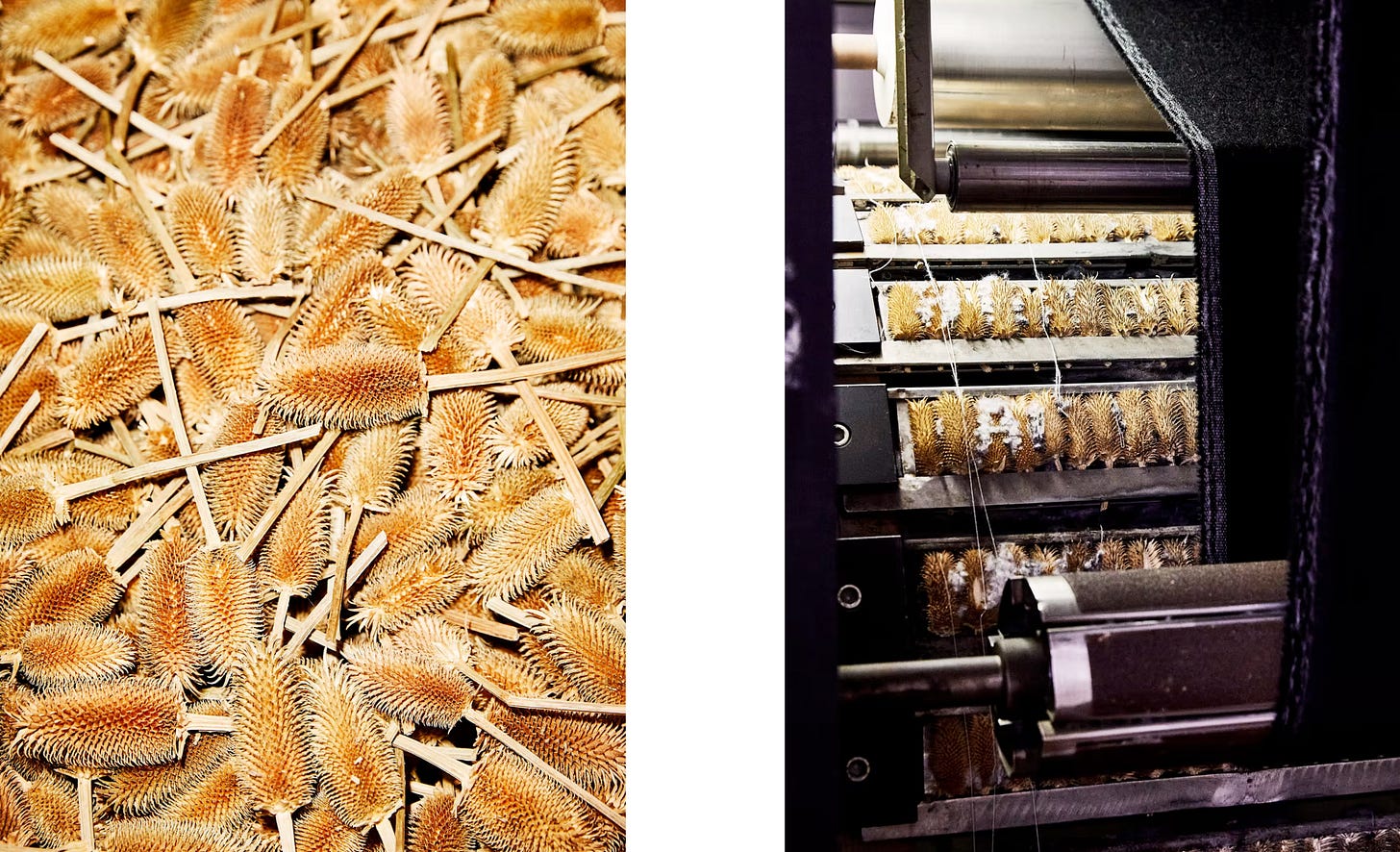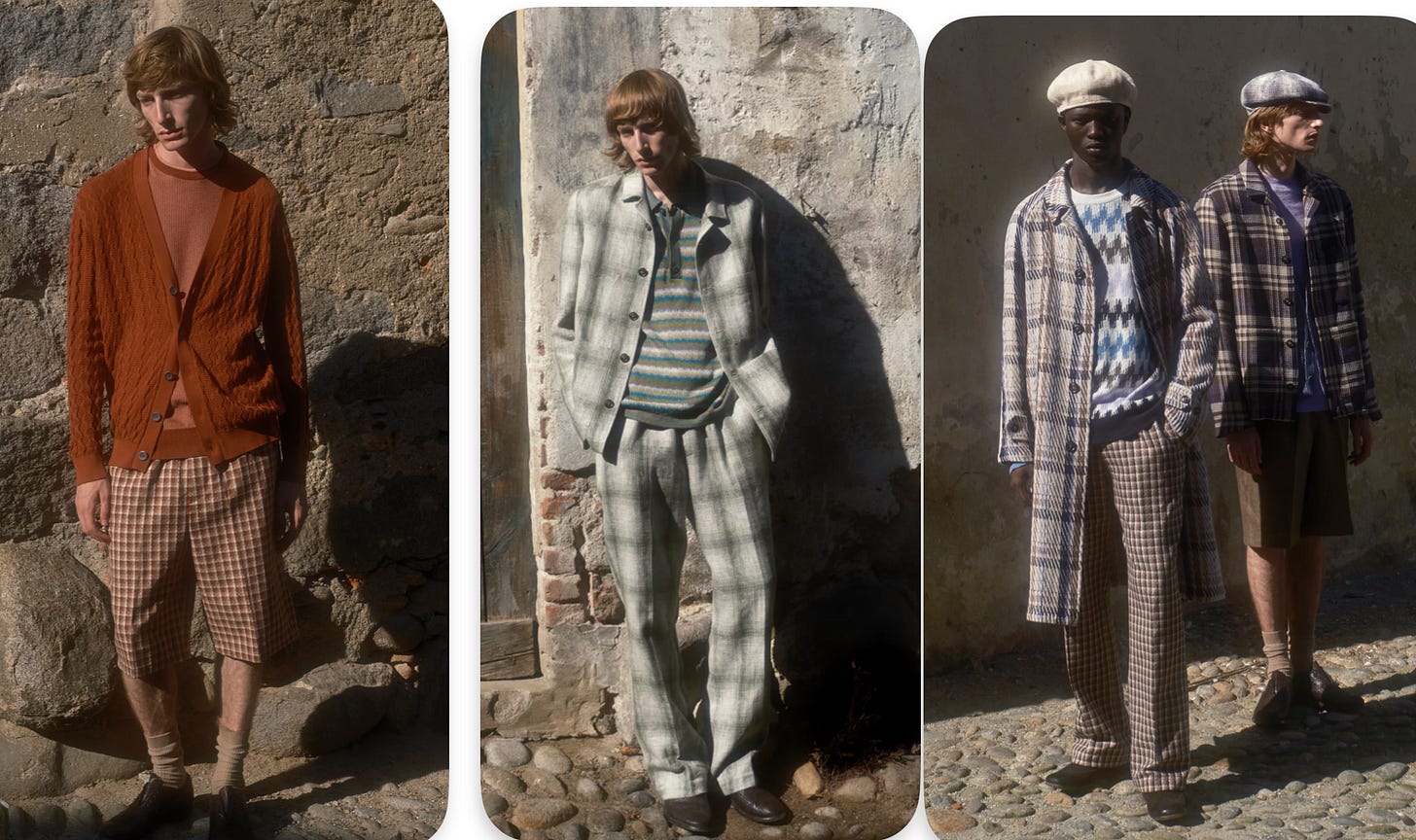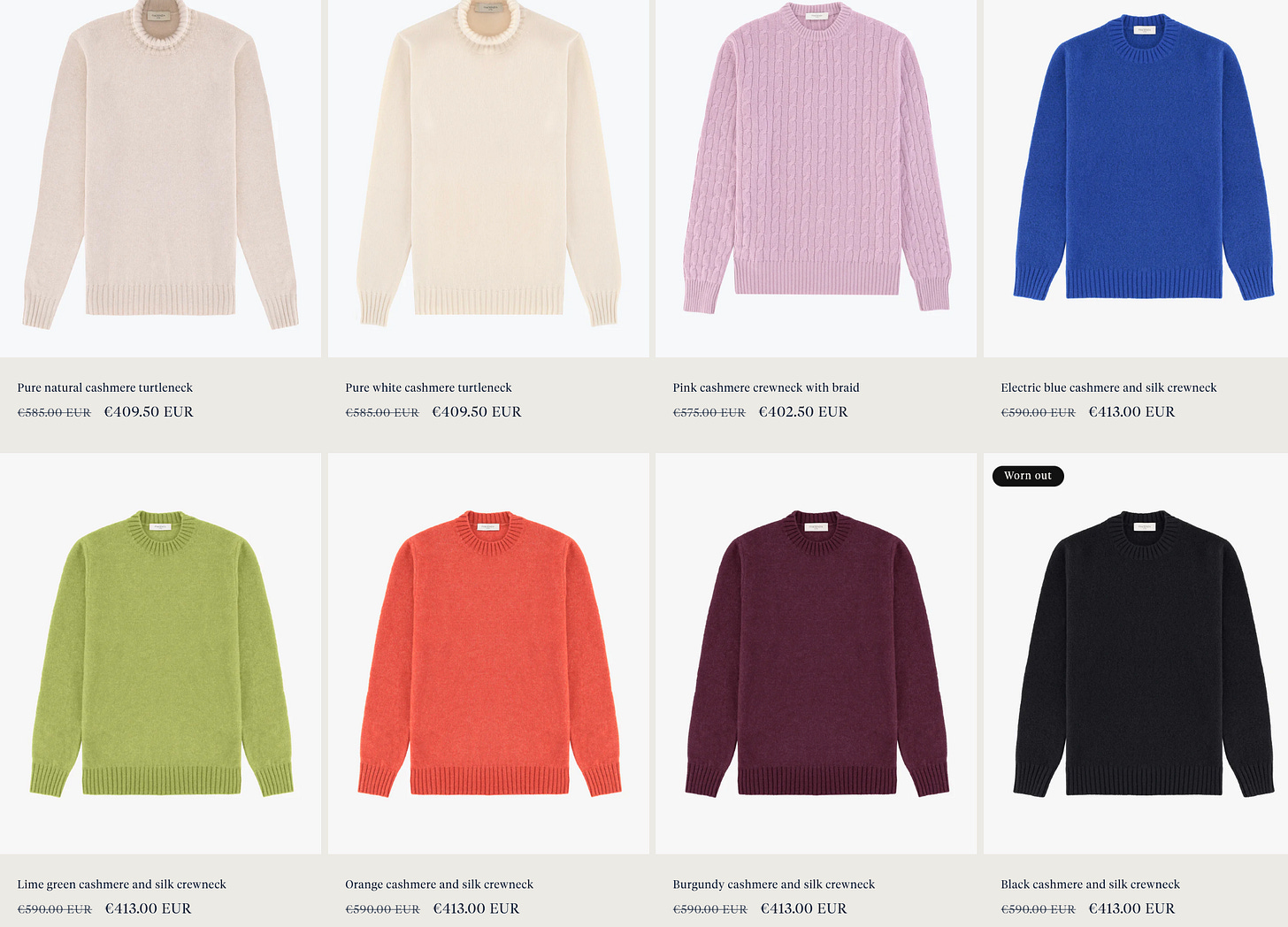Piacenza 1733 | Italy’s first cashmere yarn manufacturer, men's cashmere ready-to-wear
Piacenza 1733 is somewhat well-known in mainland China, though not as much as Cariaggi and Colombo. However, it is still a widely distributed cashmere yarn brand. Many Taobao and emerging women's clothing stores that use Piacenza fabrics will also add the relevant fabric tag, similar to how Cariaggi does.
In China, there are also brand public accounts and fabric distribution channels operated by Piacenza agents, but the market still has many unlicensed fabrics. Piacenza’s official website has even set up a whistleblower page to support anonymous reporting of illegal use.
As for Piacenza ready-to-wear collections, they are only available in Hong Kong. Piacenza 1733 has collaborated quite a few times with Hong Kong's Lane Crawford, including working with the Florence Pitti Uomo menswear exhibition. The following image is Piacenza 1733 men's wear from Hong Kong Lane Crawford. I checked, and Piacenza 1733 products are not available at Lane Crawford in mainland China.
Piacenza 1733 is better known for its fabrics, and for finished products, you can consider their cashmere sweaters, cashmere cardigans, cashmere scarves, and hats—categories that don’t demand high design standards (similar to Malo, a fabric yarn and ready-to-wear brand I wrote about earlier). As for outerwear like coats that require a strong design in terms of fit, you might want to think twice. However, coats with special textures, such as those made from baby llama and wool blends, are worth considering.
01
PIACENZA is a high-end cashmere brand from Biella, Italy, founded in 1733. It was the first Italian factory to produce cashmere fabric, and it has now been passed down through 14 generations of the family. The family is a member of the Henokiens association.
Conditions for Joining The Henokiens Association:
The company must be a family business, with operations and management largely controlled by family members. The family's values and traditions must play an important role in the company's development.
The business must have a history of over 200 years, having stood the test of time and accumulated rich experience and unique craftsmanship.
The business name must still bear the name of the founder, reflecting respect and continuity of the company’s origins and traditions.
Headquartered in Paris, the association also awards the Leonardo da Vinci Prize to family businesses excelling in innovation and tradition. This prize is typically given to companies with over 100 years of history. Past recipients include the Ferragamo family in 2011, Japan’s Kai Corporation (known for knives and scissors) in 2014, Swarovski in 2017, France's SEB Group (which owns Tefal, WMF, Moulinex, and Supor) in 2021, and Switzerland’s Caran d'Ache, a stationery brand famous for crayons and pens, in 2023. The association also includes real estate, pharmaceutical companies, and cookware businesses.
Biella is a renowned textile city in Italy, and Piacenza 1733’s headquarters is located in the small town of Pollone near Biella. Additionally, the brand has a showroom for its ready-to-wear collections in Milan.
PIACENZA has traveled to every corner of the world in search of the finest, most precious fibers. They have explored the vast plains of Australia for the best merino wool, as well as Mongolia, South America, and North America for cashmere, camel hair, alpaca wool, mohair, silk, and Qiviuk.
Piacenza’s textile factory not only possesses top-notch technical expertise but also develops the surrounding land to fully utilize natural resources. In addition to using the locally abundant natural spring water in the washing and dyeing stages, they have also employed local experts to find high-quality thistles for the carding process. This rare traditional technique uses special brushes made from thistle flowers to create layers of dense, soft fur on the fabric. The air between the fibers is isolated, providing natural insulation and producing denser, softer, and warmer fabrics. This carding process takes a long time, but the finished product is unique.
The Piacenza logo is the thistle flower shown below.
Pollone and Biella also have a dedicated natural reserve for trees, which contributes to the excellent natural environment. Further east, you’ll reach the Valdilana area, where Ermenegildo Zegna started his business in Trivero. It is now the Oasi Zegna nature reserve. The Lora Piana family also originates from Trivero, and both of these brands now have their headquarters in Milan.
Driving half an hour further east from Valdilana, you will reach the Valsesia region, where Agnona, Colombo, and Lora Piana factories are now located.
In addition to cashmere factories, high-end suit fabric companies like Fratelli Tallia di Delfino Super also have their headquarters near Biella.
The textile industry in northern Italy is highly developed, in part due to the rich water resources in the natural environment, as wool, silk, and dyeing all require water.
Piacenza believes that the production process of world-class fabrics must adhere to ethical standards. Therefore, their textile factory strives to create products that protect the natural ecosystem while respecting humanistic values. They also place great importance on diversity, gender equality, and safety for employees, believing that only by doing so can they retain talented artisans. The factory has updated and implemented protocols to reduce its carbon footprint, emphasizing animal welfare and traceability. These measures and values have led to collaborations with universities, designers, and other brands, enhancing the sense of responsibility in the industry and promoting the rich traditions of the Biella region for the benefit of future generations.
Piacenza uses dyes made from natural ingredients and was one of the first to receive certification from the ASSO Textiles and Health Association for its fully ecological fabrics.
02
Brands like Piacenza, which are fabric manufacturers with centuries of family heritage, differ from those like Lora Piana and Agnona, which have been acquired by large fashion capitals. As a result, their designs tend to be more traditional, with colors and styles that don't fully align with current trends.
This is the lookbook for the Spring/Summer 2024 collection. The fabric clearly showcases high-quality material, but the styles don’t quite match the modern trend. It has a retro vibe. I should add Piacenza to my Explained in Detail: Scottish Tartan Plaids & Classic Tweed Fabrics || 9 Iconic British Brands since Piacenza's colors and patterns have a very British feel.
Overall, I really like the plaid patterns. The colors have a high saturation and low brightness, giving off a very British retro vibe, quite unlike the typical Italian style I associate with.
I won’t go into the details of Piacenza's Vicuna fabric here, but currently, products made from 100% Vicuna are limited to scarves and pillows.
Piacenza 1733 places a strong emphasis on scarves. They have five different scarf collections, each varying in cashmere thickness, textile craftsmanship, and price. Some are solid-colored, some are double-sided with two colors, the Shine collection focuses on bright colors, the Chic collection is the lightest, the Mirror collection has medium thickness, and the Forever collection is solid-colored.
The price range is between 180 to 290 Euros.
In addition to high-quality cashmere yarn or ready-to-wear brands, which either have exceptionally high-quality cashmere—fine enough in texture, with pure colors and solid craftsmanship—or unique knitting techniques, Piacenza’s fabrics feature distinctive patterns and textures. These designs are likely created using the thistle fruit rubbing technique.
Piacenza’s coats are typically made from baby llama mixed with wool or silk mixed with wool. Currently, cashmere is still limited to scarves and cashmere sweaters.
Baby llama is one of Piacenza’s signature fabrics, and this is the first time I’ve encountered it.
Piacenza’s cashmere sweaters are mainly basic styles, similar to Malo, Johnston of Elgin, and other brands that are not particularly strong in ready-to-wear design. They focus on simple basics like high-neck cashmere sweaters and cashmere cardigans.
Now, in addition to N.Pearl’s men’s cashmere collection, Piacenza 1733 is also an option. Currently, Piacenza 1733 does not have women’s wear.
Epilogue
The more I study these century-old family brands, the more I realize there’s so much more to discover in the world.
WeChat Offcial Account : pamperherself


















